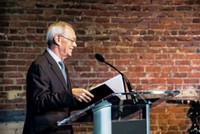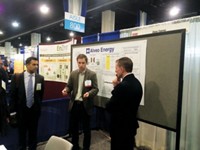Advertisement
Grab your lab coat. Let's get started
Welcome!
Welcome!
Create an account below to get 6 C&EN articles per month, receive newsletters and more - all free.
It seems this is your first time logging in online. Please enter the following information to continue.
As an ACS member you automatically get access to this site. All we need is few more details to create your reading experience.
Not you? Sign in with a different account.
Not you? Sign in with a different account.
ERROR 1
ERROR 1
ERROR 2
ERROR 2
ERROR 2
ERROR 2
ERROR 2
Password and Confirm password must match.
If you have an ACS member number, please enter it here so we can link this account to your membership. (optional)
ERROR 2
ACS values your privacy. By submitting your information, you are gaining access to C&EN and subscribing to our weekly newsletter. We use the information you provide to make your reading experience better, and we will never sell your data to third party members.
Entrepreneurship
Donald Sadoway
Materials chemist says his economical battery technology could solve the grid-scale energy storage problem
by Amanda Yarnell
August 20, 2012
| A version of this story appeared in
Volume 90, Issue 34
Wind blows when it wants. The sun doesn’t shine all the time. The inherent intermittence of wind and solar power requires electric utilities to find a way to put the generated energy away for a still, cloudy day. Annual global demand for this kind of grid-scale electricity storage will reach $113.5 billion by 2017, according to a March estimate by consulting firm Lux Research.
COVER STORY
Donald Sadoway
With that potential market in mind, many firms are scrambling to scale up already-commercialized battery technologies to store electricity for use in the nation’s electrical grid. “But these technologies are fraught with cost, efficiency, reliability, and safety hurdles,” says Donald R. Sadoway, a Massachusetts Institute of Technology materials engineering professor and founder of Cambridge, Mass.-based Liquid Metal Battery Corp. (LMBC). “You need something that can support super‑high current, has extremely long service life, and can do it all at rock-bottom cost.”
A metallurgist by training, Sadoway decided a new kind of battery was needed. Inspired by the pennies-per-pound molten metal electrolysis process used to produce aluminum, he challenged his graduate students and postdocs to develop a battery built entirely of Earth-abundant liquid components.
Sadoway says the technology that his team of students devised could reduce the cost and complexity of building battery installations capable of storing electricity for the grid.
Manufacturing the battery is simple, Sadoway notes. Metal and salt are poured into a battery cell and then heated above their melting points. Once molten, the components’ immiscibility and differing densities naturally drive the battery’s assembly: positive and negative electrodes made of molten metals, separated by a molten salt electrolyte that conducts current between them.
Thanks to these highly conductive liquid layers, the batteries can charge and discharge rapidly, responding to millisecond fluctuations of supply and demand on the power grid.
Sadoway, 62, says the technology’s commercial potential was obvious. But to demonstrate that his film-canister-sized prototype truly could be scaled up, he knew he’d need to look beyond the walls of MIT—and not only because his team had maxed out its building’s electrical capabilities. “A university is not a secure place for the development of intellectual property,” he explains. “Its mission is to disseminate knowledge, not protect it.”
Luckily, Sadoway says, he was in the right place. “MIT’s culture fosters entrepreneurship,” he says. “It’s seen as a positive not a negative for faculty to move technology off campus.”
That’s one of the reasons, Sadoway says, that MIT recently granted him a yearlong teaching sabbatical. He’s using the time to focus on serving as LMBC’s scientific adviser, working alongside his cofounder and former student, David Bradwell, who now serves as the firm’s chief technology officer, as well as Chief Executive Officer Phil Giudice, former commissioner of the Massachusetts Department of Energy Resources.
Liquid Metal Battery Corp.
Year founded: 2010
Products: Batteries for grid-scale energy storage
Number of employees: 20
Source of start-up funds: Government and private funding (Bill Gates, Total, Khosla Ventures)
Profiled founder’s current role in company: Chief scientist
Advice: Don’t shy away from a field you are not an expert in—the outsider can triumph.
Sadoway got another helping hand from MIT’s Deshpande Center for Technological Innovation, which provides financial and other support for budding entrepreneurs at the institute. “This was a perishable idea,” he says. “Getting early funding from the Deshpande Center meant we didn’t have to go through the months it takes to get a traditional proposal funded.” The money quickly got him the data he needed to attract major research funding from the Department of Energy’s Advanced Research Projects Agency-Energy (ARPA-E) program and the French energy company Total.
When it came to raising additional seed money for his fledgling company, Sadoway looked for patient investors with deep pockets. “I felt this was an unconventional technology, and I wanted it to be funded in an unconventional way,” he says. He convinced Total to put up additional funds for the company. Microsoft founder Bill Gates, who had expressed interest in Sadoway’s liquid battery idea during a visit to MIT several years prior, also agreed to kick in funds.
This May, Khosla Ventures, a venture capital firm established by Sun Microsystems founder Vinod Khosla, joined Gates and Total in backing LMBC. Together they invested an additional $15 million in the business.
Sadoway credits his success to his team’s outsider status—and its unwavering eye on cost. “My students and I were not steeped in the battery industry,” and brought fresh, untried ideas to the table, he says. “If you think by commercializing your idea you can address an unmet need—at the price point of the existing market—then by all means, pursue your dreams.”





Join the conversation
Contact the reporter
Submit a Letter to the Editor for publication
Engage with us on Twitter